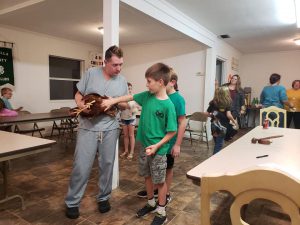4-H functions most effectively as a youth-adult partnership that fosters positive youth development. Youth-adult partnerships can take several forms. One form is a mentoring relationship between a caring adult volunteer and a 4-H youth.
Mentoring is a relationship-based process that occurs over time. The mentoring process can be formal or informal. This blog post will explore what it means to be a mentor and the importance of mentoring roles in youth development. The person being mentored may be referred to as a protégé or as a mentee. Mentoring is not a one-way relationship. The relationship can fulfill professional and socioemotional needs for both mentor and protégé (Inzer & Crawford, 2005).
Formal mentoring tends to occur within an organizational structure. A senior member of an organization or an adult may be assigned to serve in a mentoring role to a new member or to a youth. Informal mentoring relationships are voluntarily formed between two people who choose each other (Inzer & Crawford, 2005). A third, hybrid approach known as youth-initiated mentoring (YIM) is also an option as a model and may be optimal for building mentor relationships in 4-H programs (van Dam L. B., 2021).
5 Roles of the Mentor
The following mentoring roles can be accomplished within a formal or informal mentor relationship:
- Goal Setter: Help identify and prioritize the goals of the person you are mentoring.
- Adviser: Provide advice and guidance, often based on life experience and organizational knowledge.
- Cheerleader: Encourage positive actions and celebrate success.
- Growth Cultivator: Suggest activities that will help the person grow.
- Role Model: Serve as a model of potential success and provide real-life examples of how to surmount obstacles.
Goal Setter: The mentor as goal setter helps the youth to identify potential goals to set. Mentors can also play an important role in teaching youth how to balance and prioritize goals. For example, Susy may want to win a blue ribbon at the livestock show. At the same time, Susy is also trying to maintain a 4.0-grade average and work part-time. Susy’s mentor can help her to set realistic goals that help her to develop time management skills.
Adviser: It can be helpful for youth to learn from the experiences of others. For example, Michael wants to become state 4-H president. He has connected with adult volunteer Cory, who was state president when he was a 4-H youth. Cory serves as a sounding board and often shares how he learned from mistakes and was able to build on his successes to achieve his leadership goal.
Cheerleader: The cheerleader role may seem simple but also the most important. Celebrating youth successes – whether large or small – can make a big difference in a child’s life. Marking success with recognition and encouragement helps to reinforce positive behavior and helps to build a foundation for continued achievement. For example, Anna has been working on her aim during archer
y club practice. She wants to compete in an upcoming match. You observe her stance and coach her to adjust her posture. Anna is now able to hit the center target three out of four times. You praise her improvement and celebrate the achievement with her, sharing an exuberant high five.
Growth Cultivator: 4-H professionals and volunteers often refer to growing leaders and “making the best better” – the growth cultivator does these things. As a growth cultivator, a mentor helps to point youth in the direction of the next and most appropriate challenge that will help foster positive development. For example, Nathan has prepared a strong project board display for the county fair. You suggest he use that project board to develop an illustrated talk for district showcase.
Role Model: Serving as a role model for youth may seem like a full-time job! However, the key part of being a role model is honesty. Role models do not have to be perfect, but modeling honesty and how to be accountable when mistakes are made are critical elements of being a good role model. For example, you are usually early to club activities, greeting everyone with a smile and a personal acknowledgment when they come through the door. On the way to a district council meeting, you encounter heavy traffic and run late. When you arrive, your club youth members are already there and a 4-H agent has started the meeting. At the break, you shrug off your poor mood and tell your youth, “I didn’t leave early enough to allow for rush hour traffic. That is on me. I appreciate how you were all here on time and were able to participate in the meeting before I arrived.”
3 Key Elements of Effective Mentoring
A robust, growing body of research on youth mentoring suggests that a hybrid model of targeted mentoring and relational bond mentoring may produce the best outcomes for youth development (Christensen, 2020). Targeted mentoring involves a relationship focusing on a specific outcome or behavior – such as academic or career mentoring. Relational bond mentoring focuses on developing rapport and may present a more holistic approach. 4-H is built on a developmental model that uses this hybrid approach. Youth-adult relationships may initially form to reach specific goals – such as completing a project. Over time, as the youth becomes more involved with the program, relational bonds may develop. Research by Raposa et al (2019) suggests that effective youth mentoring involves an “interconnected set of three processes (i.e., social-emotional, cognitive, and identity formation processes) through which the establishment of close, caring relationships with non-parental adults are expected to promote positive developmental trajectories” (Raposa, 2019). Effective youth mentoring is likely to incorporate all three of these elements: social-emotional, cognitive, and identity formation processes.
How Does Youth-Initiated Mentoring (YIM) Work?
4-H can have an important role in providing a structured, safe environment where youth choose and develop mentoring relationships. One way to establish these type of mentoring relationships is youth-initiated mentoring (YIM). YIM is a hybrid approach in which youths and their families are helped to identify and recruit caring adult mentors from within their existing social networks (van Dam L. R., 2021).
The 4-H youth-adult partnership model provides a structure for helping youth to identify, recruit, and maintain connections with caring adults (van Dam L. B., 2021). The key elements in YIM are youth agency and choice in establishing and maintaining relationships.
Which Type of Mentor Role Fits?
The mentor role that best fits you and your mentee may incorporate one or more of the five mentor roles. It is likely that at some point during a long-term mentoring relationship a mentor will have played all of the five roles in supporting their mentor.
Become a Mentor with 4-H!
As a 4-H volunteer, you will opportunities to serve as a mentor to youth looking to form relationships with caring adults. To learn more about how to get involved, reach out to your local UF/IFAS County Extension office.
References:
- Christensen, K. H. (2020). Non-Specific versus Targeted Approaches to Youth Mentoring: A Follow-up Meta-analysis. Journal of Youth and Adolescence, 959–972.
- Inzer, L., & Crawford, C. (2005). A Review of Formal and Informal Mentoring: Processes, Problems, and Design. Journal of Leadership Education, 33-50.
- Raposa, E. R. (2019). The Effects of Youth Mentoring Programs: A Meta-analysis of Outcome Studies. Journal of Youth and Adolescence, 423–443.
- van Dam, L. B. (2021). Youth Initiated Mentoring: A Meta-analytic Study of a Hybrid Approach to Youth Mentoring. J Youth Adolescence, 219–230.
- van Dam, L. R. (2021). Youth-Initiated Mentoring as a Scalable Approach to Addressing Mental Health Problems During the COVID-19 Crisis. JAMA Psychiatry, 818.
- All About Tabletop Exhibits for the North Florida Fair - September 10, 2024
- Beyond the Blue Ribbon: Make the Most of the 4-H Experience with Your Local Fair - July 5, 2024
- Tips to Help Youth and Families Handle Back-to-School Stress - July 28, 2023


